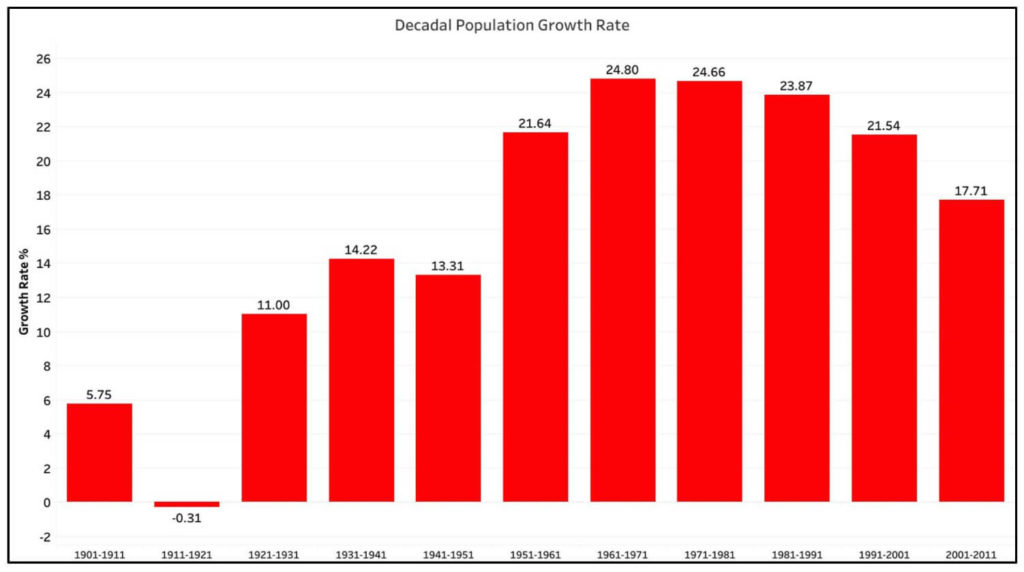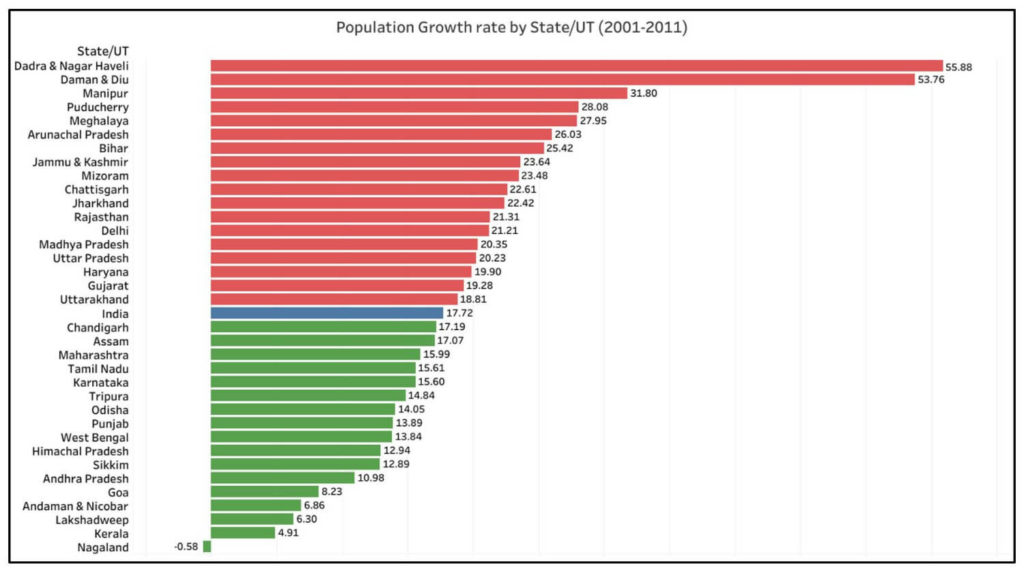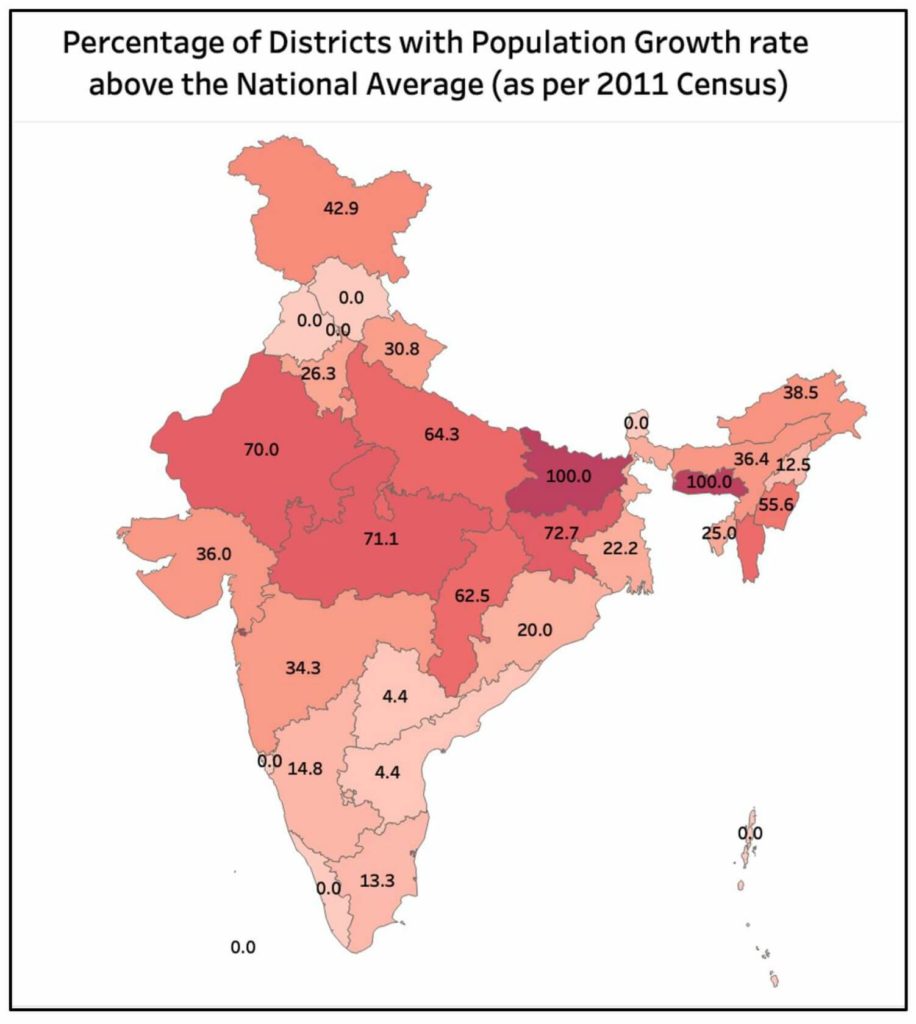[orc]Ever since the Prime Minister mentioned population growth and the need to be concerned about population explosion, in his Independence day speech, opinions are divided on the issue. In a two-part series, we look at the numbers from Census 2011 to understand the issue in greater detail.
In his Independence Day speech this year, Prime Minister Narendra Modi said that the country needs to worry about population explosion and mentioned that increasing population poses various new challenges.
The debate around population growth is divided. But what do the numbers say about population growth in India? In a two-part series, we look at numbers from the Census 2011 to understand the differences in population growth rates across the country, both in terms of geographies and communities.
Decreasing trend in population growth rate over last Four decades
The latest available census data is for 2011 and this data is compared it with the previous census data of 2001 for arriving at growth rates for the purpose of this analysis. The population of the country as per 2011 census was 121.08 crores, whereas in 2001 it was 102.86 crores. In other words, the population grew by 17.71% over this decade which is less than 21.54% growth rate in the previous decade (1991-2001). This is in continuation of declining growth rate observed since 1971-81 where the growth percentage was 24.65% and in the ensuing decade of 1981-91, the population grow at 23.86%. This could be the result of emphasis on family planning and national level campaigns around family planning. The reduction in population growth rates in the recent decades follows the increasing trend observed between 1951-71.

However, the decline in growth rate over the last decade is not uniform across the country.
Population Growth rate in many of the Hindi speaking states more than the National Average
Apart from being the states with higher population in India, the states of UP, Bihar and MP also have higher population growth rate over the period 2001-2011.
Among the bigger states, Bihar has the highest population growth rate with 25.42%. J&K has was next with a growth rate of 23.64% followed by Chhattisgarh, Jharkhand and Rajasthan at 22.61%, 22.42% and 21.31% respectively.
Uttar Pradesh and Madhya Pradesh which rank 1st and 6th respectively among the states in terms of population, have a growth rate of 20.23% and 20.35% respectively. Other states in the Northern and Western part of India also have a higher rate of population growth than the national average.
The population growth rate of the southern states is less than national average of 17.71% for 2001-2011. Kerala had the least population growth with only 4.91% followed by Andhra Pradesh (before bifurcation) with 10.98%. Karnataka and Tamil Nadu also have lower population growth with approximately 15.6% for both the states. Maharashtra and West Bengal which are the 2nd and 4th most populated states in the country, also have population growth rates less than national average.
Among the smaller states, Manipur, Meghalaya, Arunachala Pradesh and Mizoram have higher rate of population growth compared to the national average while Goa, Sikkim & Tripura have a growth rate less than the national average. The state of Nagaland has a negative rate of growth during 2001-11.

Districts with more than 50 Lakh population among those with the highest growth rate
As per 2001 census, there were a total of 593 districts in India, which increased to 640 districts as per 2011 census. To facilitate analysis and comparison, the population of new districts as per 2011 census is included in their parent districts for comparison with the 2001 figures. Overall, 45% of the districts in India have a population growth rate more than the national average.
A total of 20 districts in India have a population of more than 50 lakhs as per the 2011 census of which 13 districts have a growth rate more than the national average. The average growth rate of these top 20 districts is 22.13%. Most of these are urban centers which attract a lot of inward migration.
35 districts in India have population between 40-50 lakhs of which 34% districts are above the national average in terms of population growth rate. Further, 49% of the 73 districts with population between 30-40 lakhs have the population growth more than India’s growth rate.
Nearly half of 115 districts with population between 20-30 lakhs are above the nations’ population growth. A majority of the districts in India have population less than 20 lakhs. Of which, 41% of 192 districts between 10-20 lakhs, and 36% of the 157 districts with population less than 10 lakhs have the population growth rate above the nation’s average.

Bihar, UP, MP and Rajasthan account for a large number of districts with rate of growth more than national average
All the 37 districts in Bihar have a growth rate more than India’s population growth rate. Of these, 18 districts have population growth rate even higher than Bihar’s average of 25.62%. Jharkhand, Madhya Pradesh, Rajasthan, Uttar Pradesh and Chhattisgarh are the other states where the population growth rate in more than 50% of the districts is more than India’s population growth rate.
In Jharkhand, 72% of the districts have a higher population growth rate than the national average. Further, 11 out of 18 districts in Jharkhand have population growth rate more than the state’s average of 23.92%.
32 of 45 districts in Madhya Pradesh have population growth more than that of India. Of these, 19 districts have population growth rate more than the state’s average growth rate.
Out of the 45 districts in UP, which have population growth rate higher than India, 26 of them have the growth rate higher than UP’s average. The population of Bahraich district grew by 46% by adding 11.06 lakhs in the decade between 2001-2011. The population in Ghaziabad, in Uttar Pradesh grew by 13.9 Lakhs i.e. by 42%.
In Rajasthan,the population of Jaipur District increased by 13.75 Lakhs i.e. 26% higher than the state’s growth rate of 19%.
Kerala has no district which has population growth rate higher than India’s growth rate. However, Malappuram district has a population growth rate of 13% which is significantly higher than the state’s average of approximately 5%. It is also the highest populated district in Kerala.
Of the other big states, Punjab also does not have any district with a higher growth rate than national average. In erstwhile Andhra Pradesh, only one district (Rangareddy, surrounding the capital city of Hyderabad) recorded a higher growth rate.
It also has to be noted that some of the districts where population growth is more than the state or national average are urban districts, which are the destination for inward migrants.

High population growth of Northern States offsetting the contribution of Southern states towards lower population growth rate.
The national population growth rate has been on the decline in the last four decades largely due to the contribution of the southern states. The high population growth rate of the Hindi heartland states (UP, Bihar, Jharkhand, MP, and Rajasthan) is offsetting any potential benefit from the lower population growth in the south. The growth of population is high across the districts in these states with rare exceptions. While few North Eastern states also recorded higher population growth, this is largely due to the lower population base and hence may not impact India’s population growth significantly. In the case of the Hindi heartland states, it is higher population growth combined with higher growth rates.
In Part-2, we look at some of the districts with unusually high population growth rate across the country and if there is correlation with community wise growth rates.
Featured Image: Population growth rate in India



1 Comment
Pingback: What is the change in Hindu & Muslim population share between 2001 & 2011? - Fact Checking Tools | Factbase.us